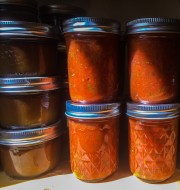You may have heard that you are supposed to pinch out basil flowers as soon as they appear, and that is good advice. Once a plant begins to flower it shifts its focus to making seeds, rather than leaves. And the longer you can delay that the better.
But this year I took it a step further, and pruned my basil plants hard after they’d begun to flower. It worked great! I got an entirely new flush of leaves, doubling my harvest and more importantly prolonging my fresh basil season.
Here’s the short story, in photos.
When you’re basil is looking all scraggly and totally done, like this:

Cut each stem back all the way to the lowest set of leaves, so that it ends up looking like this:

Give it a dose of liquid fish fertilizer, keep it well watered and a few weeks later, it will look like this!

Here’s the long story, in big words.
Plants have two main ways that they make new growth, or rather, two different places with the kind of cells which can differentiate into various plant anatomy. Most often plants grow from the tip of the stem, called the apical meristem, because this helps them grow tall fast and get a literal leg up on the competition. But they can also grow from the axillary or lateral buds located in the crotch of each leaf node, so that if an herbivore comes along and chomps the apical meristem off (usually the choicest, most tender part of a plant) they have a plan B. Some plants are better at this than others. Tomatoes have such voracious axillary growth that they quickly become a jungle of stems, and a neglected tomato patch (also called a compost pile) can soon require a machete to enter.
Although less rampant, basil has good axillary growth as well, and you can often already see a new set of leaves or even a small stem forming in the axil of the larger leaf.
When you cut back the old flowering stems, you are removing the apical meristem, and the growth hormones that would normally get shunted all the way to those tips, instead get diverted to the axillary buds and spur them into action. The plants knows it will need to accumulate some energy to recover from the pruning, so it makes a new round of leaves for photosynthesis rather than staying fixed on the flowering idea. (Hopefully.)
Most mint family plants (most of our herbs are from this big, aromatic family) are really good at this, and that’s why you should never be shy with your harvests. Keep cutting the ends of each stem, with a few sets of leaves for dinner, and your plant will only get bushier.




You must be logged in to post a comment.